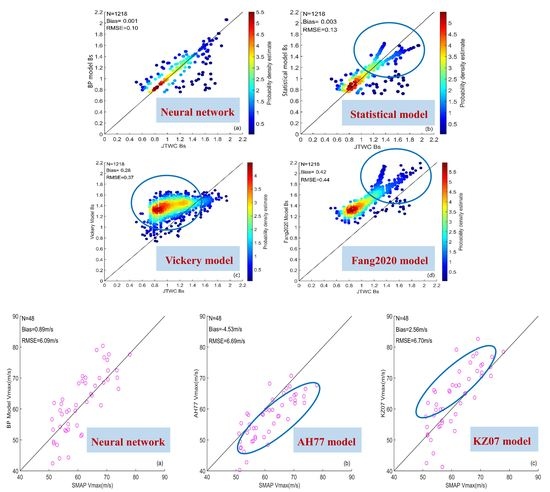Estimating the Key Parameter of a Tropical Cyclone Wind Field Model over the Northwest Pacific Ocean: A Comparison between Neural Networks and Statistical Models
Abstract
1. Introduction
2. Data
2.1. JTWC Best-Track Data
2.2. SMAP TC Sea Surface Wind Field Data
3. Methodology
3.1. Definition of Holland B Parameter for Sea Surface Wind Field
3.2. Backpropagation Neural Network
4. Results
4.1. Parameter Sensitivity Analysis
4.2. Validation of Neural Network Results
4.3. Application to Wind Pressure Model
4.4. Comparison with Our Statistical Models
4.5. Comparison with Other Statistical Models
5. Discussion
6. Conclusions
- Comparing the simulation results of the network constructed by different input schemes for the testing data reveals that the neural network only considers inputting TC center pressure difference has the best performance. The deviation and RMSE of are only −0.001 and 0.10. The MWS of TCs calculated by the constructed neural network combined with the wind pressure model is compared with the MWS of JTWC. The result also shows that the neural network that only considers TC center pressure difference performs best and the deviation and RMSE of MWS are only 0.06 and 1.61 m/s.
- The results of the statistical models established in this study, also show that the TC central pressure difference is the most important factor to and the introduction of other variables does not significantly improve the model results. When the value is greater than 1.2, the simulation results of these statistical models exhibit significant underestimation or overestimation. The Fang2020 model also represents a similar phenomenon when simulating . However, the neural network in this study can significantly improve the underestimation and overestimation, indicating that the BP neural network can capture the nonlinear distribution of the values that cannot be described by traditional statistical methods and obtain a more accurate value of the parameter.
- To study the details of the model in different typhoon cases, we divide the testing data into super typhoon group and nonsuper typhoon group according to typhoon intensity. For the super typhoon group, the MWS simulated by the two existing wind pressure models, the AH77 model and the KZ07 model is underestimated and overestimated. The deviations are −4.76 and 2.53 m/s, whereas the deviation of neural network is appropriate (0.14 m/s). For the nonsuper typhoon group, the performance gap of the three models is not so remarkable. It shows that our neural network has more advantages in simulating the MWS of super typhoons.
- The MWS of super typhoons observed by the spaceborne microwave radiometer SMAP is also used to verify the network in detail. The experimental results show that the simulated MWS of the AH77 model is significantly underestimated, with a deviation of −4.53 m/s and the simulated MWS of the KZ07 model is overestimated, with a deviation is 2.56 m/s. Our neural network, whose deviation is only 0.89 m/s, also improves the underestimation and overestimation phenomena.
Author Contributions
Funding
Institutional Review Board Statement
Informed Consent Statement
Data Availability Statement
Acknowledgments
Conflicts of Interest
References
- Harper, B.A. Tropical Cyclone Parameter Estimation in the Australian Region: Wind–Pressure Relationships and Related Issues for Engineering Planning and Design—A Discussion Paper; Systems Engineering Australia Party Ltd.: Newstead, Australia, 2002; SEA Rep. J0106-PR003E; p. 83. [Google Scholar]
- Atkinson, G.D.; Holliday, C.R. Tropical Cyclone Minimum Sea Level Pressure/Maximum Sustained Wind Relationship for the Western North Pacific. Mon. Weather. Rev. 1977, 105, 421–427. [Google Scholar] [CrossRef]
- Knaff, J.A.; Zehr, R.M. Reexamination of Tropical Cyclone Wind–Pressure Relationships. Weather. Forecast. 2007, 22, 71–88. [Google Scholar] [CrossRef]
- Schloemer, R.W. Analysis and Synthesis of Hurricane Wind Patterns over Lake Okeechobee, Florida; U.S. Department of Commerce, Weather Bureau: Washington, DC, USA, 1954. [Google Scholar]
- Holland, G.J. An Analytic Model of the Wind and Pressure Profiles in Hurricanes. Mon. Weather. Rev. 1980, 108, 1212–1218. [Google Scholar] [CrossRef]
- Love, G.; Murphy, K. The Operational Analysis of Tropical Cyclone Wind Fields in the Australian Northern Region. North. Territ. Reg. Res. Papers 1984, 85, 44–51. [Google Scholar]
- Hubbert, G.D.; Holland, G.J.; Leslie, L.M.; Manton, M.J. A Real-Time System for Forecasting Tropical Cyclone Storm Surges. Weather. Forecast. 1991, 6, 86–97. [Google Scholar] [CrossRef]
- Harper, B.A.; Holland, G.J. An updated parametric model of the tropical cyclone. In Proceedings of the 23rd Conference Hurricanes and Tropical Meteorology, Dallas, TX, USA, 10–15 January 1999. [Google Scholar]
- Vickery, P.J.; Skerlj, P.F.; Steckley, A.C.; Twisdale, L.A. Hurricane Wind Field Model for Use in Hurricane Simulations. J. Struct. Eng. 2000, 126, 1203–1221. [Google Scholar] [CrossRef]
- Willoughby, H.; Rahn, M. Parametric representation of the primary hurricane vortex. Part I: Observations and evalua-tion of the Holland (1980) model. Mon. Weather Rev. 2004, 132, 3033–3048. [Google Scholar] [CrossRef]
- Jakobsen, F.; Madsen, H. Comparison and further development of parametric tropical cyclone models for storm surge modelling. J. Wind. Eng. Ind. Aerodyn. 2004, 92, 375–391. [Google Scholar] [CrossRef]
- Powell, M.; Soukup, G.; Cocke, S. State of florida hurricane loss projection model: Atmospheric science component. J. Wind Eng. Ind. Aerodyn. 2005, 93, 651–674. [Google Scholar] [CrossRef]
- Vickery, P.J.; Dhiraj, W. Statistical models of Holland pressure profile parameter and radius to maximum winds of hurricanes from flight-level pressure and H*Wind data. J. Appl. Meteorol. Climatol. 2008, 47, 2497–2517. [Google Scholar] [CrossRef]
- Holland, G. A Revised Hurricane Pressure–Wind Model. Mon. Weather. Rev. 2008, 136, 3432–3445. [Google Scholar] [CrossRef]
- Xiao, Y.; Duan, Z.; Ou, J.; Chang, L.; Li, Q. Typhoon wind hazard analysis for southeast China coastal regions. Struct. Saf. 2011, 33, 286–295. [Google Scholar] [CrossRef]
- Lin, W.; Fang, W.H. Study on regional characteristics of Holland B parameter in typhoon wind field model for Northwest Pacific. Trop. Geogr. 2013, 33, 124–132. [Google Scholar]
- Li, S.H.; Hong, H.P. Use of historical best track data to estimate typhoon wind hazard at selected sites in China. Nat. Hazards 2014, 76, 1395–1414. [Google Scholar] [CrossRef]
- Zhao, L.; Lu, A.; Zhu, L.; Cao, S.; Ge, Y. Radial pressure profile of typhoon field near ground surface observed by distrib-uted meteorologic stations. J. Wind Eng. Ind. Aerodyn. 2013, 122, 105–112. [Google Scholar] [CrossRef]
- Fang, G.; Zhao, L.; Song, L.; Liang, X.; Zhu, L.; Cao, S. Reconstruction of radial parametric pressure field near ground sur-face of landing typhoons in northwest pacific ocean. J. Wind Eng. Ind. Aerodyn. 2018, 183, 223–234. [Google Scholar] [CrossRef]
- Fang, P.; Ye, G.; Yu, H. A parametric wind field model and its application in simulating historical typhoons in the western North Pacific Ocean. J. Wind. Eng. Ind. Aerodyn. 2020, 199, 104131. [Google Scholar] [CrossRef]
- Meissner, T.; Ricciardulli, L.; Wentz, F.J. Capability of the SMAP Mission to Measure Ocean Surface Winds in Storms. Bull. Am. Meteorol. Soc. 2017, 98, 1660–1677. [Google Scholar] [CrossRef]
- Yueh, S.H.; Fore, A.G.; Tang, W.; Hayashi, A.; Stiles, B.; Reul, N. SMAP L-Band Passive Microwave Observa-tions of Ocean Surface Wind During Severe Storms. IEEE Trans. Geosci. Remote 2016, 54, 7339–7350. [Google Scholar] [CrossRef]
- Fore, A.G.; Yueh, S.H.; Stiles, B.W.; Tang, W.; Hayashi, A.K. SMAP Radiometer-Only Tropical Cyclone Intensity and Size Validation. IEEE Geosci. Remote Sens. Lett. 2018, 15, 1480–1484. [Google Scholar] [CrossRef]
- Sun, Z.; Zhang, B.; Zhang, J.A.; Perrie, W. Examination of Surface Wind Asymmetry in Tropical Cyclones over the Northwest Pacific Ocean Using SMAP Observations. Remote Sens. 2019, 11, 2604. [Google Scholar] [CrossRef]
- Olfateh, M.; Callaghan, D.P.; Nielsen, P.; Baldock, T.E. Tropical cyclone wind field asymmetry-Development and evaluation of a new parametric model. J. Geophys. Res. Ocean. 2017, 122, 458–469. [Google Scholar] [CrossRef]
- Kang, N.-Y.; Elsner, J.B. Consensus on Climate Trends in Western North Pacific Tropical Cyclones. J. Clim. 2012, 25, 7564–7573. [Google Scholar] [CrossRef][Green Version]
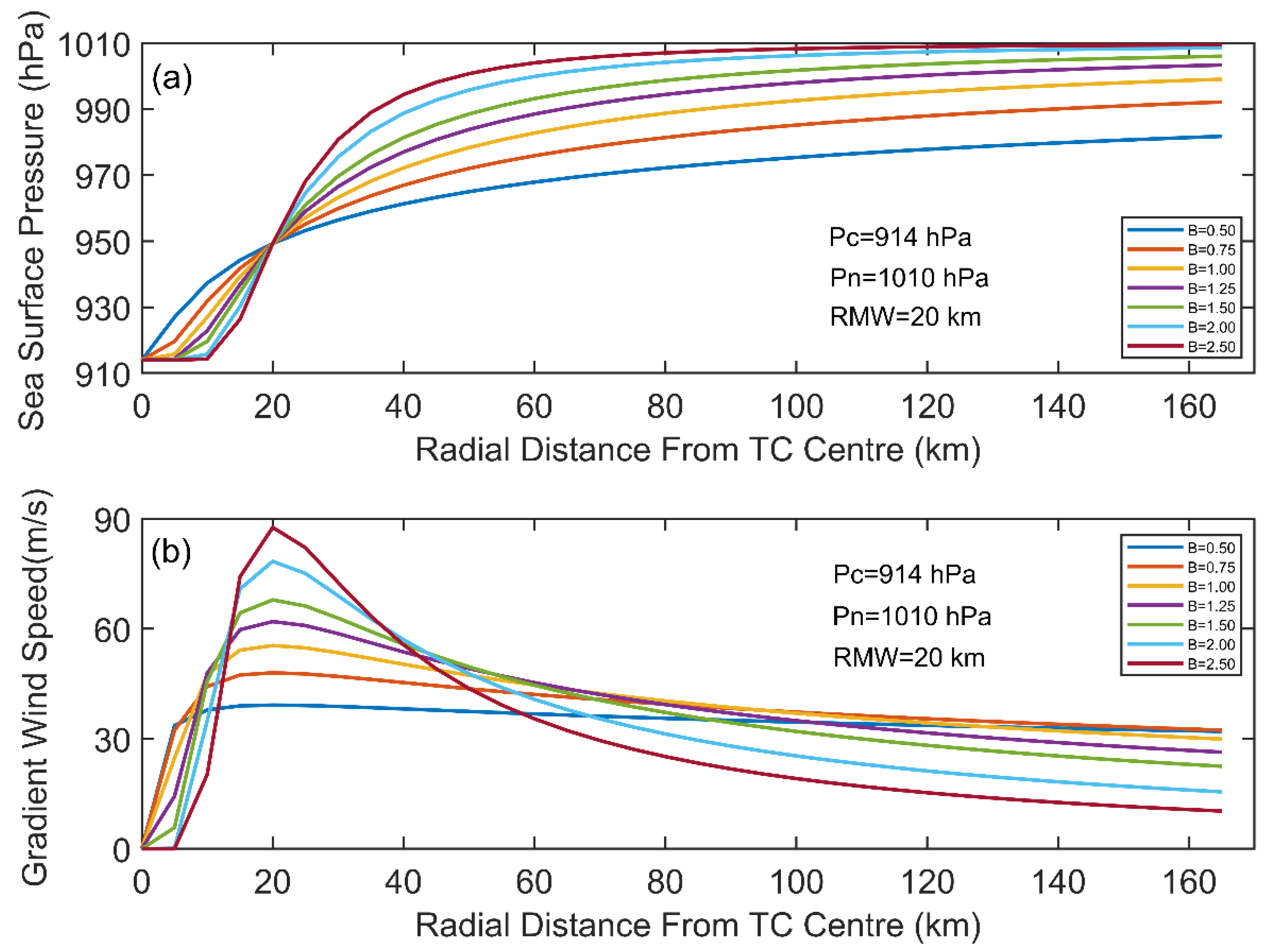
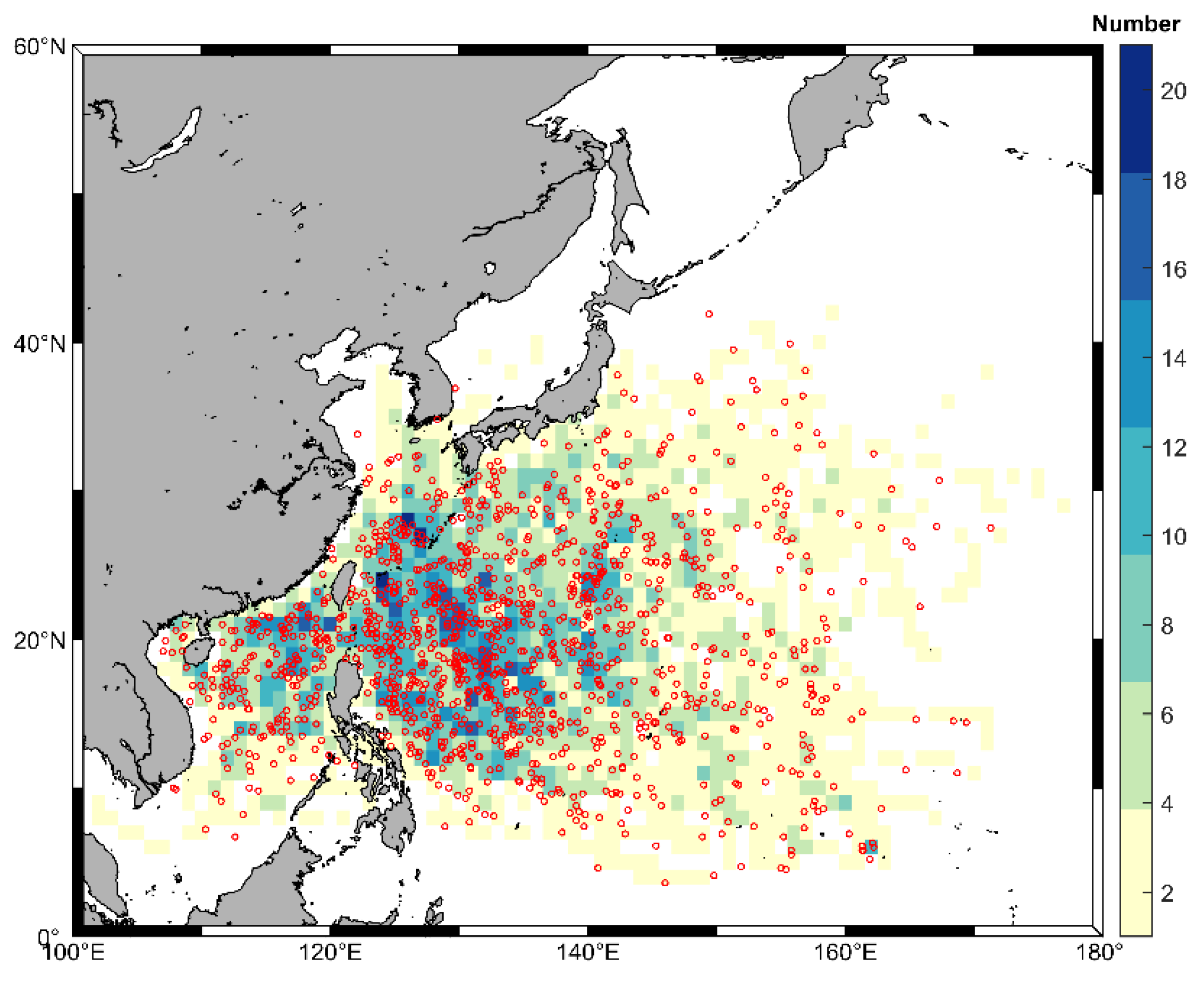
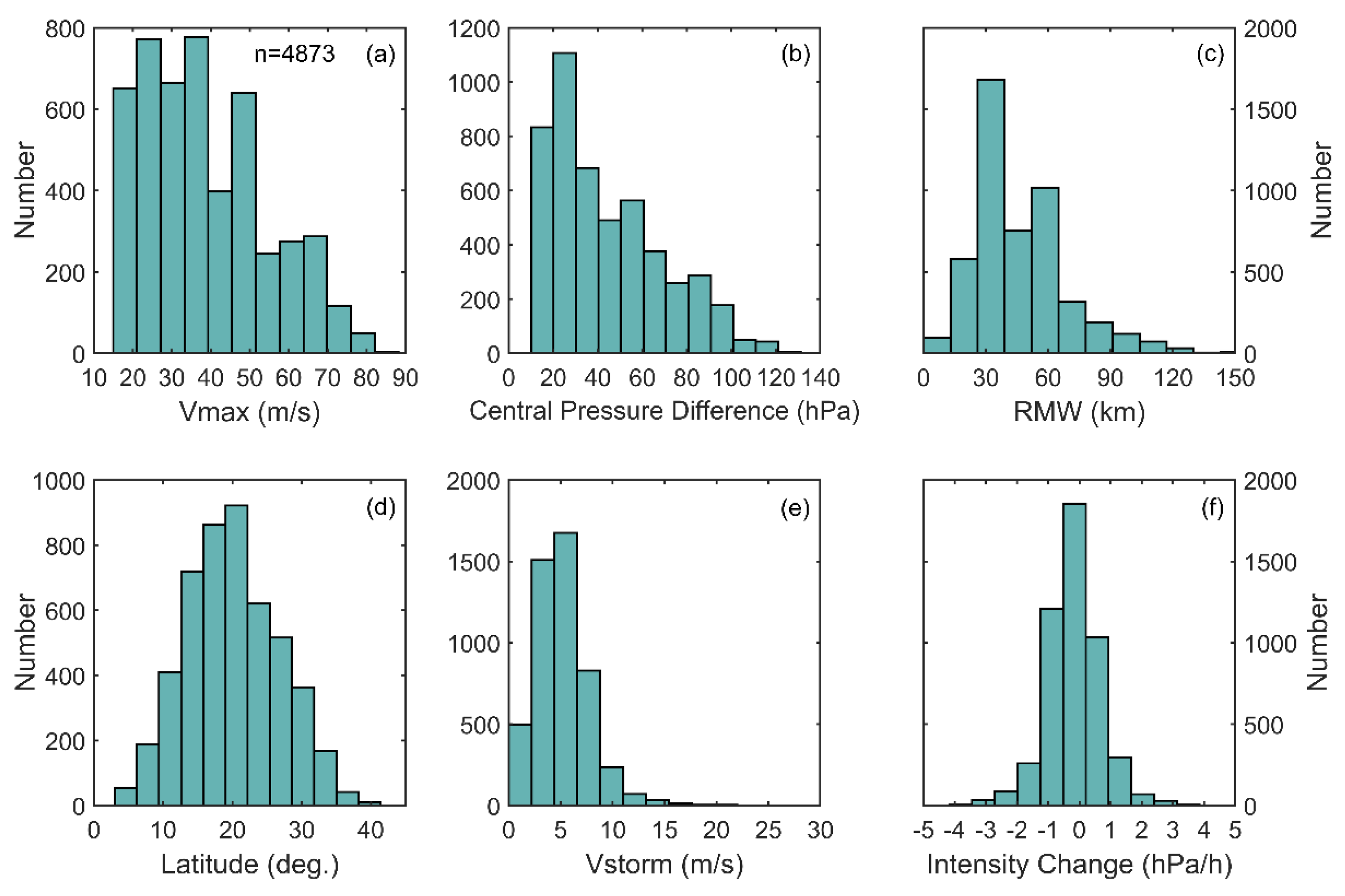
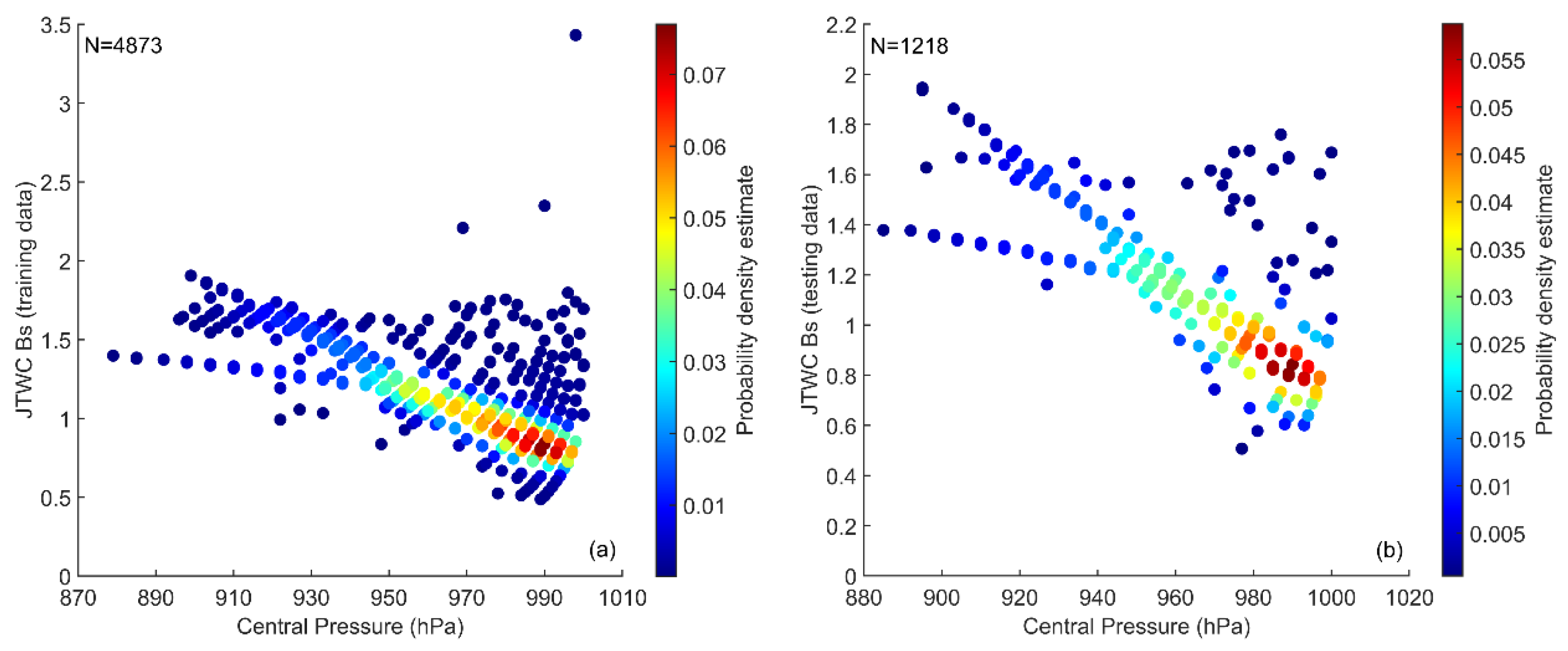
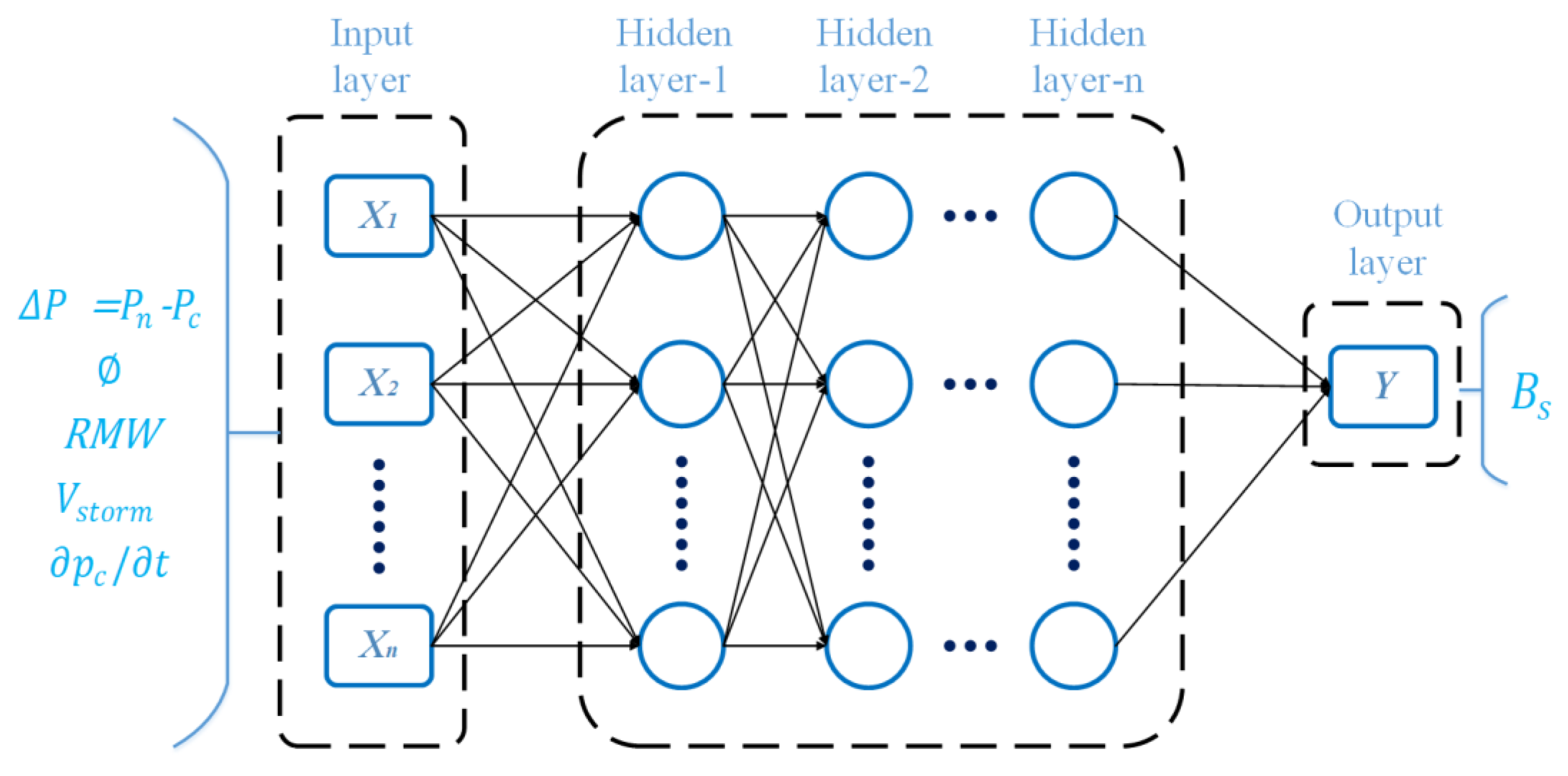
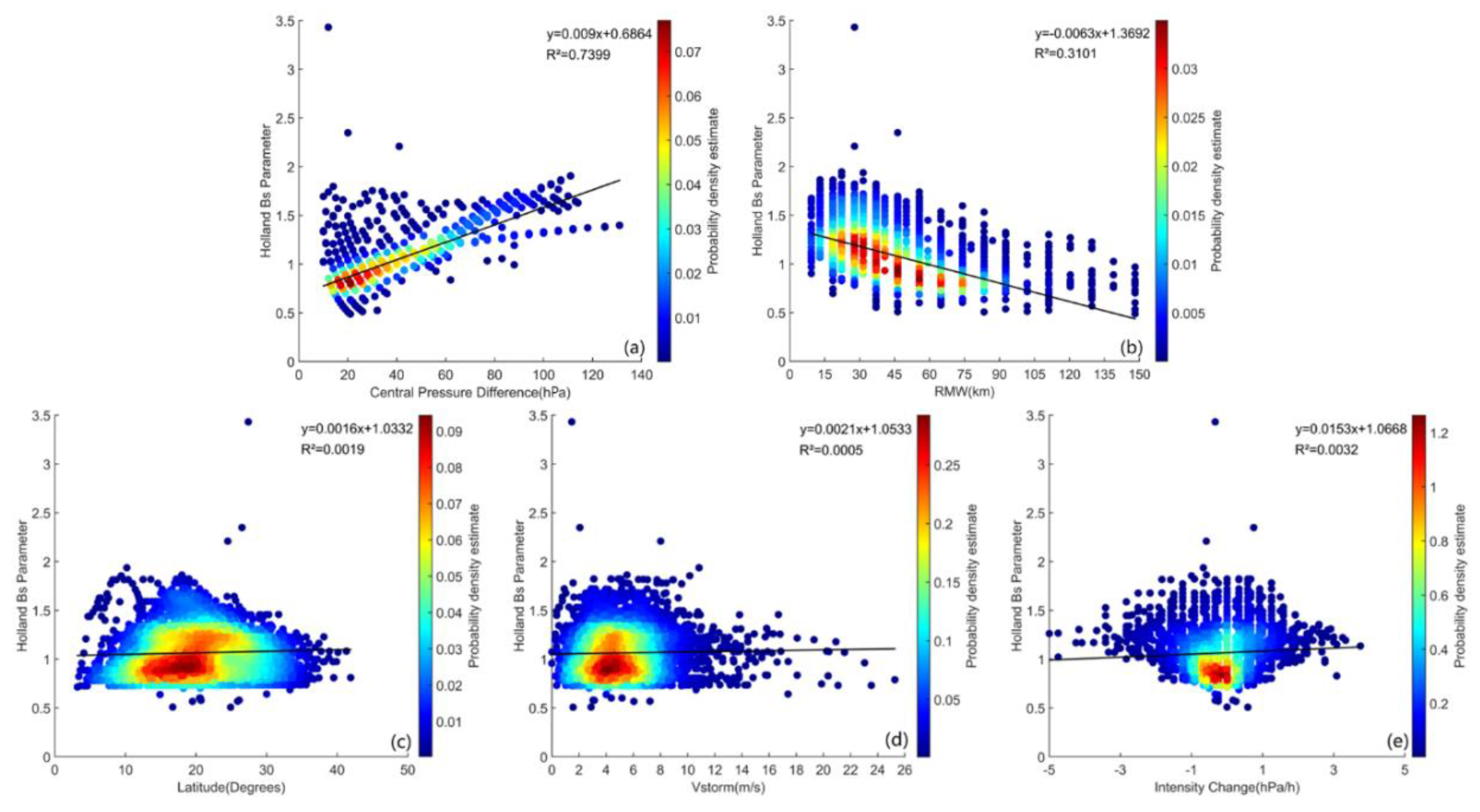
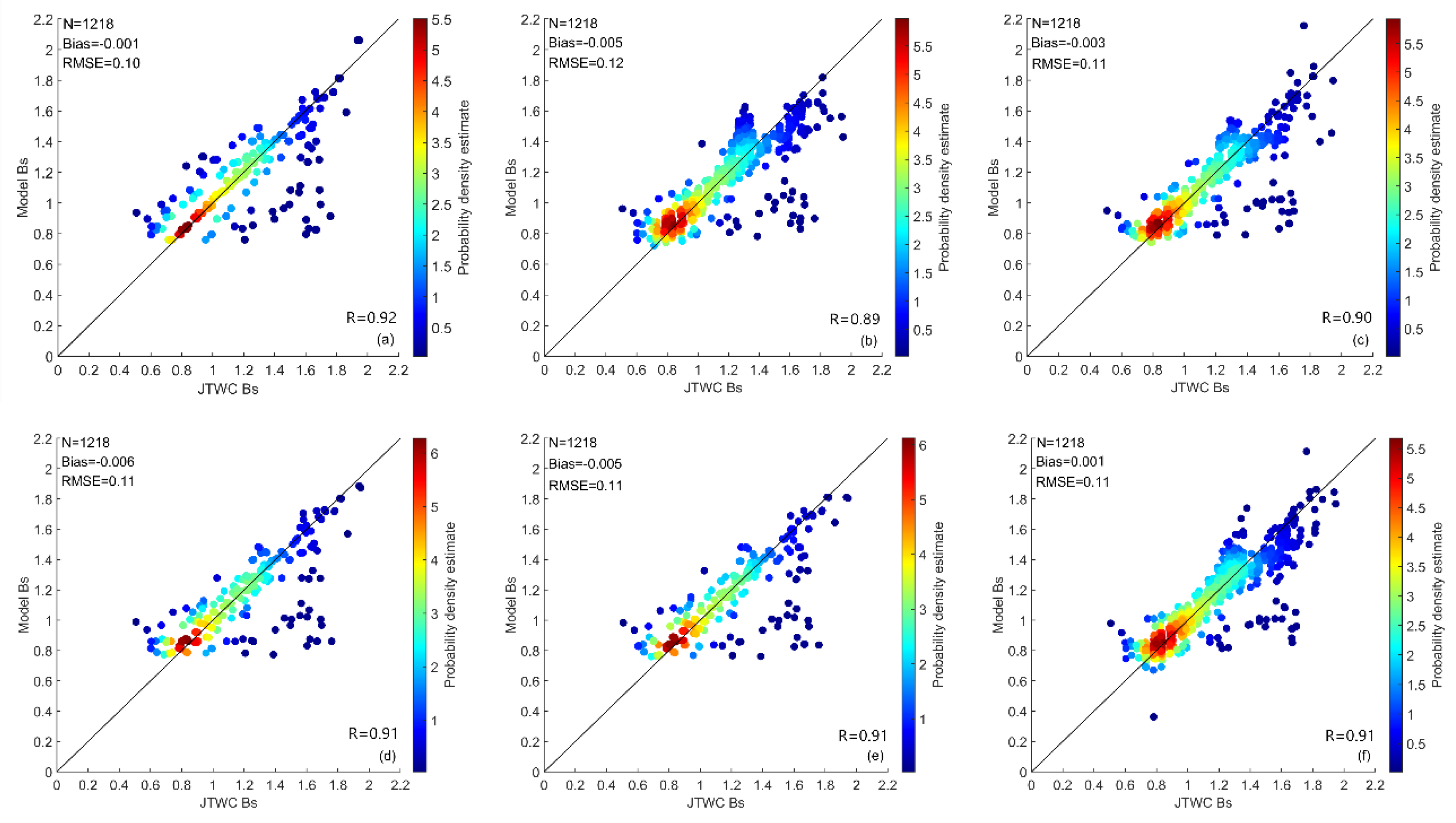

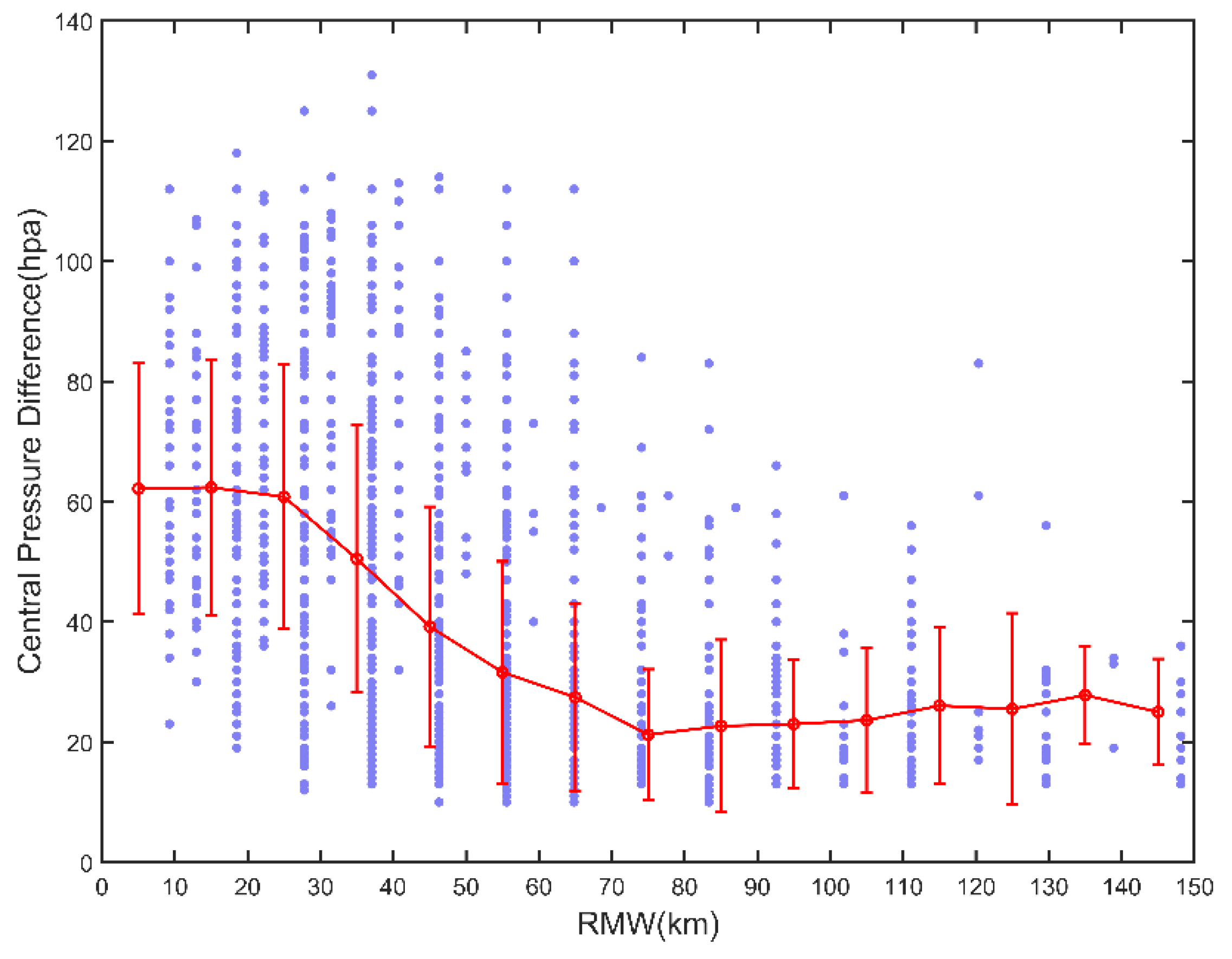
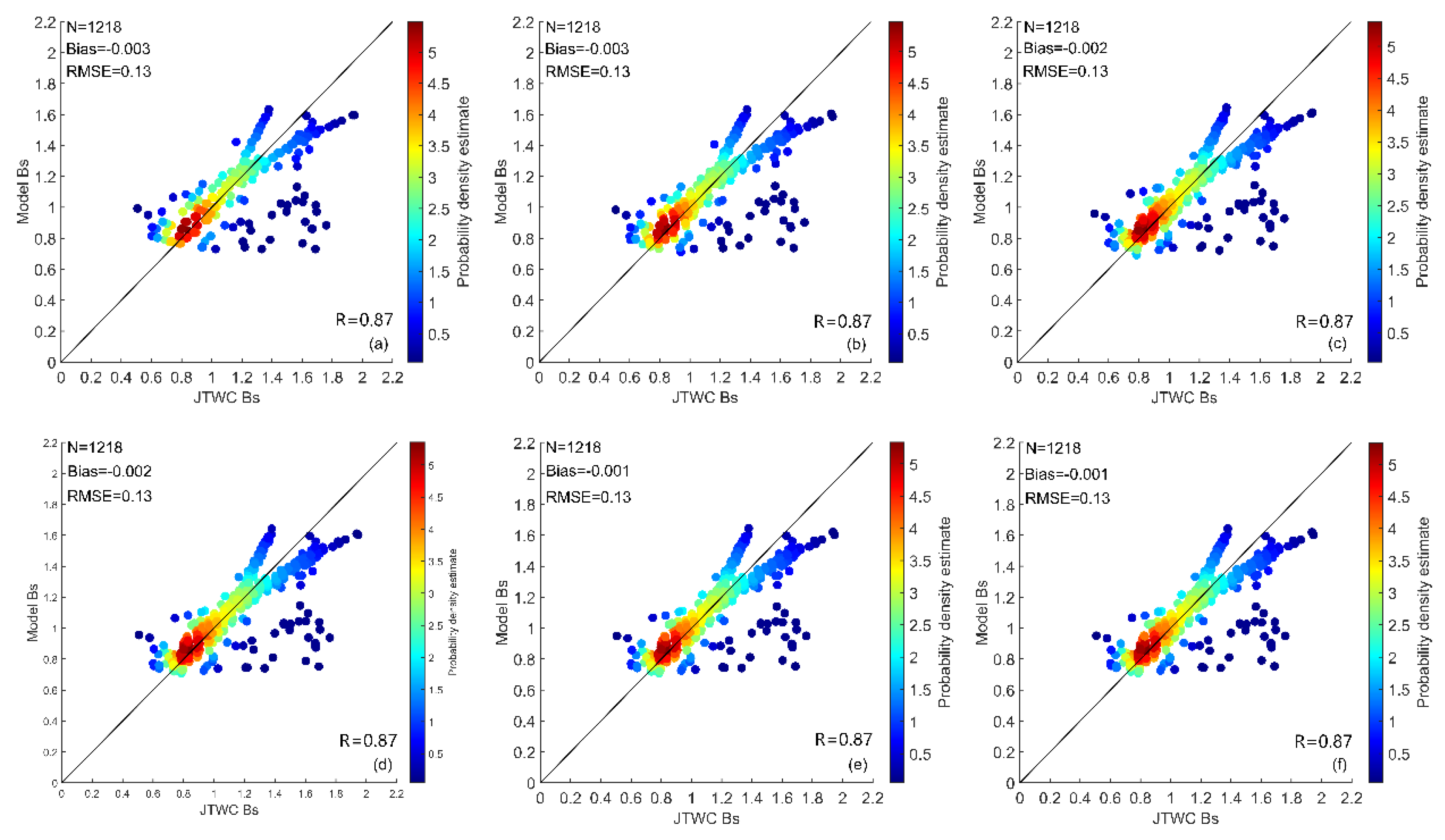

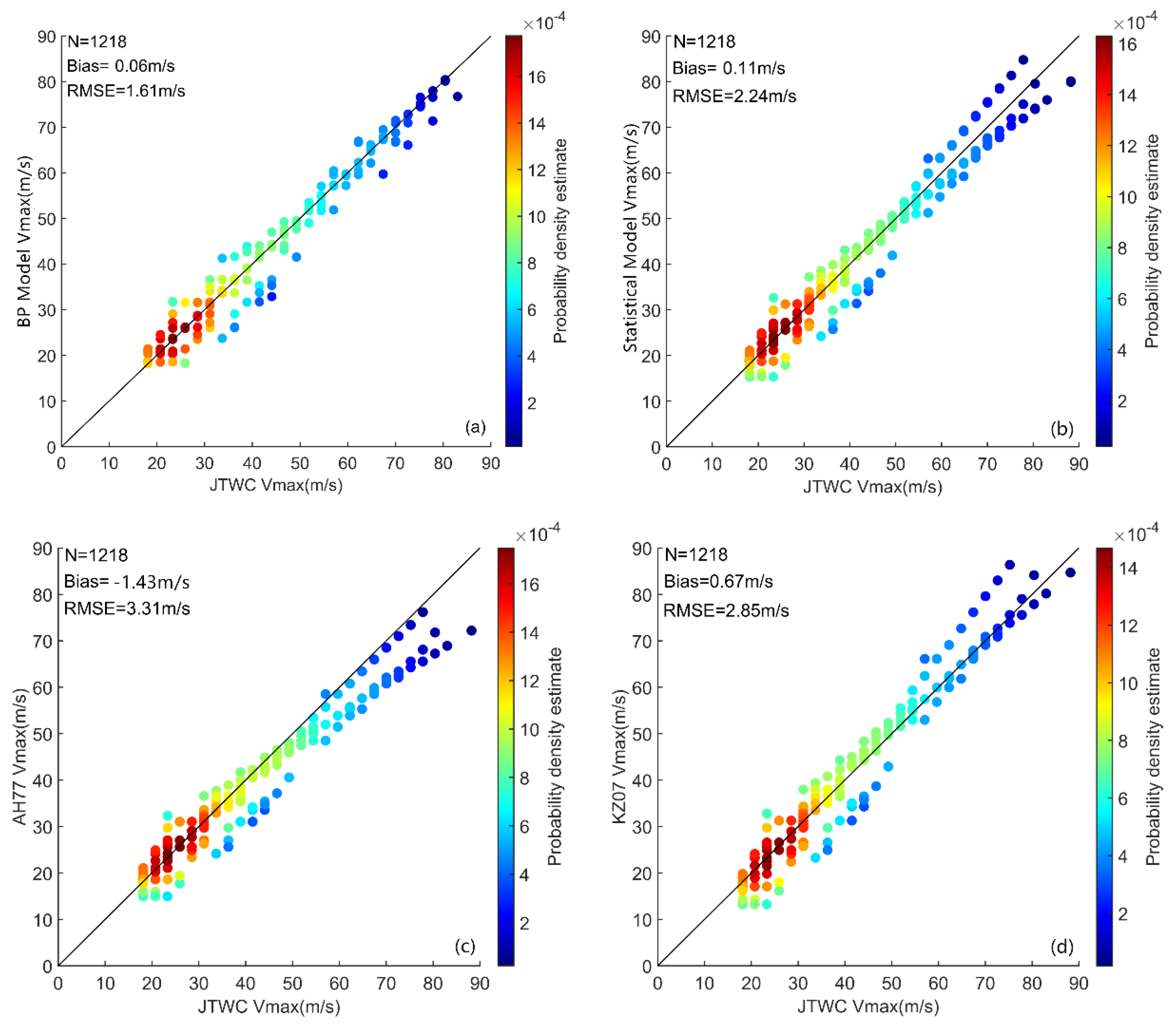
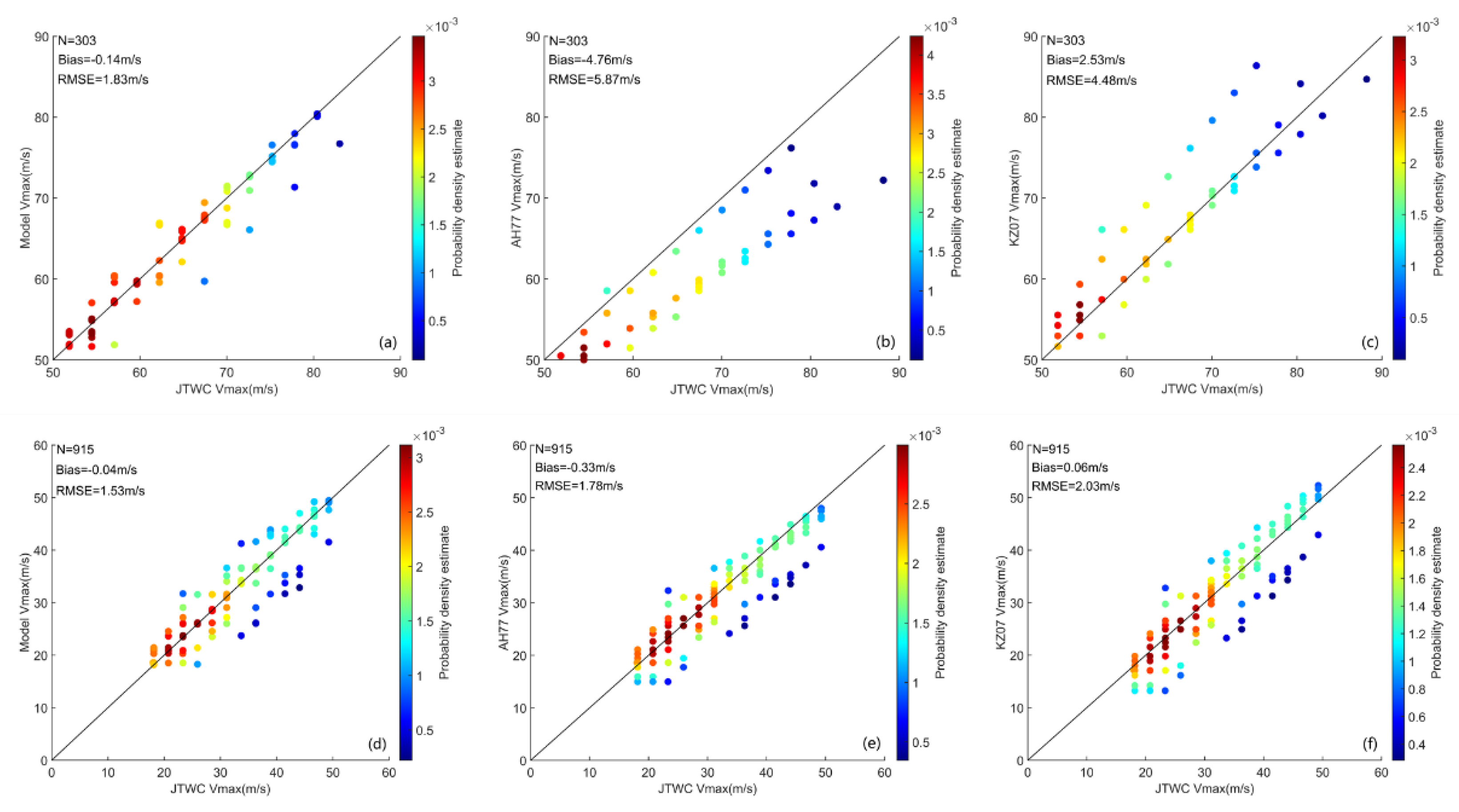

| Serial Number | Formula | Research Area | Reference |
|---|---|---|---|
| (1) | Australia | 1985 [6] | |
| (2) | Australia | 1991 [7] | |
| (3) | Australia | 1999 [8] | |
| (4) | Atlantic | 2000 [9] | |
| (5) | Atlantic | 2004 [10] | |
| (6) | The bay of Bengal | 2004 [11] | |
| (7) | Atlantic | 2005 [12] | |
| (8) | Atlantic | 2008 [13] | |
| (9) | Atlantic | 2008 [14] | |
| (10) | NWP | 2011 [15] | |
| (11) | (before landfall) (after landfall) | NWP | 2013 [18] |
| (12) | NWP | 2018 [19] | |
| (13) | NWP | 2020 [20] |
| Year | Name of Super Typhoons | Occurrence Time of Super Typhoons Observed by SMAP | MWS of Super Typhoons Extracted Directly from SMAP Wind Field Data (m/s) |
|---|---|---|---|
| 2015 | Noul | 9 May 2015-09:50 | 56.94 |
| Noul | 9 May 2015-22:00 | 73.61 | |
| Dolphin | 15 May 2015-20:46 | 54.52 | |
| Nangka | 9 July 2015-08:00 | 61.52 | |
| Soudelor | 3 August 2015-08:35 | 60.28 | |
| Soudelor | 3 August 2015-20:44 | 74.02 | |
| Soudelor | 7 August 2015-09:27 | 56.68 | |
| Atsani | 18 August 2015-20:07 | 54.26 | |
| Dujuan | 27 September 2015-09:40 | 64.50 | |
| Dujuan | 27 September 2015-21:46 | 59.36 | |
| Champi | 22 October 2015-20:44 | 51.69 | |
| In-fa | 21 November 2015-21:12 | 51.44 | |
| Melor | 13 December 2015-21:36 | 54.68 | |
| 2016 | Nepartak | 5 July 2016-21:22 | 70.42 |
| Nepartak | 6 July 2016-21:58 | 70.67 | |
| Meranti | 12 September 2016-09:02 | 73.45 | |
| Malakas | 16 September 2016-21:59 | 61.36 | |
| Chaba | 2 October 2016-21:58 | 62.60 | |
| Chaba | 4 October 2016-09:30 | 55.96 | |
| Songda | 12 October 2016-19:51 | 51.28 | |
| Haima | 17 October 2016-21:23 | 59.10 | |
| Haima | 18 October 2016-22:00 | 68.87 | |
| 2017 | Noru | 31 July 2017-08:37 | 53.85 |
| Lan | 22 October 2017-08:52 | 61.05 | |
| 2018 | Maria | 7 July 2018-08:23 | 63.06 |
| Maria | 8 July 2018-09:00 | 66.46 | |
| Maria | 8 July 2018-21:07 | 70.16 | |
| Jebi | 1 September 2018-08:24 | 70.36 | |
| Jebi | 2 September 2018-21:06 | 55.55 | |
| Jebi | 3 September 2018-21:41 | 53.65 | |
| Mangkhut | 13 September 2018-09:10 | 77.93 | |
| Mangkhut | 13 September 2018-21:22 | 69.08 | |
| Mangkhut | 14 September 2018-09:49 | 67.43 | |
| Trami | 24 September 2018-21:33 | 62.65 | |
| Trami | 29 September 2018-09:14 | 52.77 | |
| Kong-rey | 1 October 2018-08:47 | 51.80 | |
| Yutu | 24 October 2018-08:10 | 68.62 | |
| Yutu | 24 October 2018-20:20 | 61.62 | |
| Yutu | 25 October 2018-20:57 | 65.94 | |
| Yutu | 28 October 2018-09:00 | 67.95 | |
| Yutu | 29 October 2018-09:37 | 59.72 | |
| 2019 | Wutip | 24 February 2019-08:21 | 51.59 |
| Wutip | 24 February 2019-20:33 | 53.85 | |
| Wutip | 25 February 2019-21:09 | 56.12 | |
| Lingling | 6 September 2019-09:39 | 51.02 | |
| Bualoi | 22 October 2019-08:22 | 64.81 | |
| Bualoi | 22 October 2019-20:30 | 56.63 | |
| Bualoi | 24 October 2019-08:00 | 56.73 |
| Scheme | Input Variables | Number of Hidden Layers | Number of Neurons in Each Hidden Layer |
|---|---|---|---|
| Network-1 | 2 | 17, 12 | |
| Network-2 | , | 2 | 12, 19 |
| Network-3 | , RMW | 2 | 19, 11 |
| Network-4 | , RMW, | 3 | 1, 18, 17 |
| Network-5 | , RMW,, | 3 | 1, 20, 13 |
| Network-6 | , RMW,,, | 3 | 12, 11, 3 |
| Serial Number | Fitted Expression |
|---|---|
| (1) | |
| (2) | |
| (3) | |
| (4) | |
| (5) | |
| (6) |
Publisher’s Note: MDPI stays neutral with regard to jurisdictional claims in published maps and institutional affiliations. |
© 2021 by the authors. Licensee MDPI, Basel, Switzerland. This article is an open access article distributed under the terms and conditions of the Creative Commons Attribution (CC BY) license (https://creativecommons.org/licenses/by/4.0/).
Share and Cite
Sun, Z.; Zhang, B.; Tang, J. Estimating the Key Parameter of a Tropical Cyclone Wind Field Model over the Northwest Pacific Ocean: A Comparison between Neural Networks and Statistical Models. Remote Sens. 2021, 13, 2653. https://doi.org/10.3390/rs13142653
Sun Z, Zhang B, Tang J. Estimating the Key Parameter of a Tropical Cyclone Wind Field Model over the Northwest Pacific Ocean: A Comparison between Neural Networks and Statistical Models. Remote Sensing. 2021; 13(14):2653. https://doi.org/10.3390/rs13142653
Chicago/Turabian StyleSun, Ziyao, Biao Zhang, and Jie Tang. 2021. "Estimating the Key Parameter of a Tropical Cyclone Wind Field Model over the Northwest Pacific Ocean: A Comparison between Neural Networks and Statistical Models" Remote Sensing 13, no. 14: 2653. https://doi.org/10.3390/rs13142653
APA StyleSun, Z., Zhang, B., & Tang, J. (2021). Estimating the Key Parameter of a Tropical Cyclone Wind Field Model over the Northwest Pacific Ocean: A Comparison between Neural Networks and Statistical Models. Remote Sensing, 13(14), 2653. https://doi.org/10.3390/rs13142653






